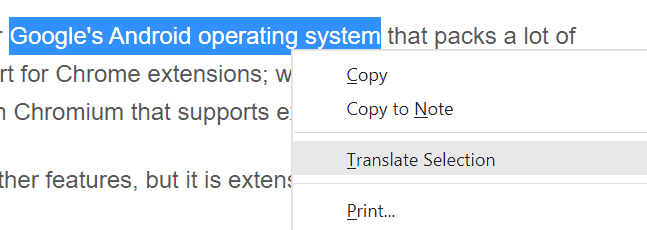You may soon translate text bits in Vivaldi Browser

Vivaldi Technologies introduced translate functionality in Vivaldi 4.0, released in June 2021. Soon, Vivaldi users will be able to translate selected text on any webpage they visit.
Vivaldi's translate feature does not rely on Google Translate, Bing Translate or other major translation services, but on a self-hosted instance of Lingvanex to make sure that user privacy is preserved while using the browser's translation feature.
The page translation feature is available already, and Vivaldi may offer to translate non-system language pages automatically on visit. You get the usual options to set up languages so that they are translated automatically.
Vivaldi does not support selection-based translating up until now; this changes in the next stable version of the Vivaldi browser, as the translation of selections becomes available in that version.
The translation feature works similarly to that in other browsers. Select text on a webpage, right-click on the selection and pick translate selection from the menu.
Vivaldi opens an overlay on the page that displays the selection in the detected language and translated to the system language.
You may change the source and destination language for the translation using the menu, e.g. change the language Vivaldi Browser translated the text to, to a non-system language.
A click on the close icon or a click anywhere else on the page closes the translation overlay again.
A keyboard shortcut is not set by default, but since you can map nearly any function in Vivaldi with keyboard shortcuts, you can do so for the translate feature as well.
Just select Vivaldi Menu > Tools > Settings, switch to the Keyboard settings menu when the Preferences open, open the Page section and scroll down to the "Translate Selected Text" field. Activate the field and add the desired keyboard combination to the field.
You may use the newly mapped keyboard shortcut from that moment on to translate text in the Vivaldi web browser.
Closing Words
Text-based translation is a missing feature of current versions of Vivaldi. The introduction of the feature in the next stable release of the browser improves the translation feature significantly; an option to translate typed text could be useful as well, but is missing at the time of writing.
You can check out the full changelog of the latest Vivaldi snapshot release here.
Now You: does your browser of choice support translate functionality? Do you use it?
Vivaldi hasnt been worth me using, its just another OPERA Bloatware Browser,
Hi martin please add this :
You can enable ‘translate selected text’ in settings>webpages>webpages.
A popup button will appear to translate text
Hallo, Martin is this article a follow up from your article? And this new function a result of that Vivaldi technologies partnered up with the firm Lingvanex?
https://www.ghacks.net/2021/03/24/vivaldi-gets-a-privacy-preserving-translation-service/
Does this translate text bits function makes a app like “Translate web pages” redundant?
Is it even wise to remove it because otherwise it interferes with the function of the browser?
https://github.com/FilipePS/Traduzir-paginas-web
Hi!
You could say it is a follow-up. The original translate service the article you linked to described was just the full page translate option using the self-hosted translate component. Now, this is extended to include an option to translate a selection of text, and not just the entire page.
If you are happy with the quality of the translation and if all languages are supported, you don’t need another translate service (unless the extension adds something extra that the native implementation does not offer).
Can’t tell you how much I am waiting for this!